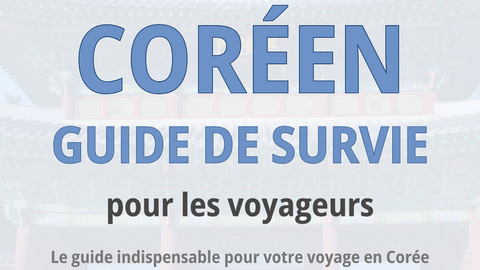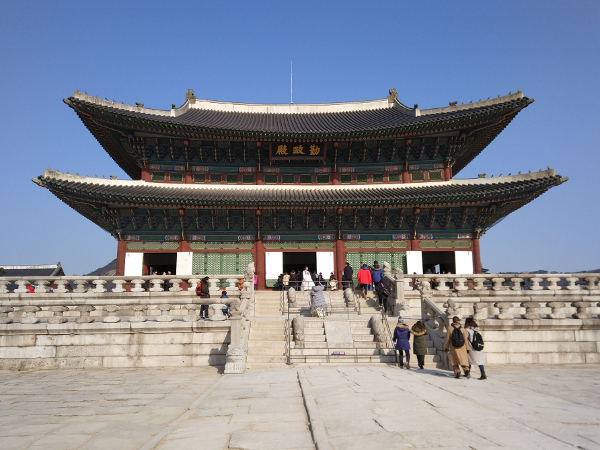Cours de coréen ᚛ Level 1 - My First Steps in Korean (Lessons 1 to 30) ᚛ Leçon 11 - Korean Sentence Structure
Korean Sentence Structure
A sentence in Korean is constructed in a very different way than a sentence in English. This is also the main difficulty when learning the language: it’s impossible to translate word for word! We will have to think directly in Korean.
The placement of the verb
This is THE main rule of Korean grammar, and the most important. Read carefully:
THE VERB IS ALWAYS PLACED AT THE END OF A SENTENCE.
English sentences generally follow the “Subject + Verb + Objects” structure.
In Korean, the sentence “I eat kimchi” becomes “I kimchi eat”.
As for objects, we can put them in more or less any order we want, as long as the verb is at the end.
It is possible that my last sentence surprised you. Yes, grammatically speaking, all objects can go wherever we want. So how can we understand a sentence in Korean if everything can be placed in whichever order? Thanks to particles!
The language of particles
In Korean, most word groups are followed by a grammatical particle. It is a small element (usually one or sometimes two syllables) which indicates the grammatical function of what precedes it.
For example :
- 는 indicates that what comes before is the topic of the sentence.
- 를 indicates that what comes before is the direct object.
These particles will allow us to relate the elements of the sentence in order to understand it.
Take the sentence:
저는 김치를 먹어요.
There are three groups:
- the last group, 먹어요, is the verb. It means "to eat", conjugated in the present
- the first group ends with 는, so this is the topic of the sentence. 저, which precedes it, means “I”. This sentence therefore concerns “I”, myself.
- the second group ends with 를, this is the direct object. 김치 is kimchi, the famous Korean fermented cabbage.
So, the sentence, when translated to English, becomes:
I eat kimchi.
A sentence in any order
Grammatically, the order of objects does not matter in Korean as long as the verb is at the end.
Take the sentence:
저는 포크로 김치를 먹어요.
Compared to the sentence in the previous section, we added 포크로. 포크 is a fork, 로 is the particle used to express the way to perform an action. 포크로 therefore indicates that the action is performed with a fork.
저는 포크로 김치를 먹어요.
→ I eat kimchi with a fork.
What happens if we reverse the two objects 포크로 and 김치를?
저는 김치를 포크로 먹어요.
It changes absolutely nothing! Indeed, thanks to the presence of the particles, there is no ambiguity as to the role of each word in this sentence. 김치 is always the direct object, marked by the particle 를; 포크 is always the way to perform an action, marked by the particle 로.
In practice, some sentences may sound unnatural to Korean ears depending on the word order, although they are completely grammatically correct. It is through practice that you will be able to know if a sentence sounds good or not. In general, it’s best to place the subject at the beginning of the sentence, then the other elements, from least important to most important, and end with the verb. But we will see all of this when we form more complex sentences.
Simplify as much as possible!
When Koreans speak in everyday conversation, you will notice very quickly that the sentences are simplified. Indeed, some particles can be omitted in order to cut down sentences. Of course, do not try this by yourself for the moment and wait to follow the next courses!
Even better, the subject is sometimes completely removed. In our previous example, if we know we are talking about “I”, about myself, this is unnecessary information that can be removed.
Our sentence then becomes:
김치 먹어요.
→ I eat kimchi.
Exercises
En savoir +
Voyager en Corée du Sud peut être une expérience inoubliable. Mais quand on ne parle pas coréen, tout devient plus compliqué : commander au restaurant ou dans un café devient stressant ; on ne comprend aucun panneau ni enseigne ; en cas de souci, demander de l'aide est presque impossible ; et surtout, on manque l'essence même d'un voyage réussi en Corée : l'échange avec les locaux.
Comme les traducteurs automatiques français - coréen ne peuvent pas être fiables car les deux langues fonctionnent d'une manière totalement opposée, il devient alors crucial de se préparer soi-même pour profiter pleinement de son voyage en Corée du Sud.
Nous avons alors créé un guide conçu spécialement pour les voyageurs qui souhaitent profiter de la Corée sans galère linguistique !
En savoir +

